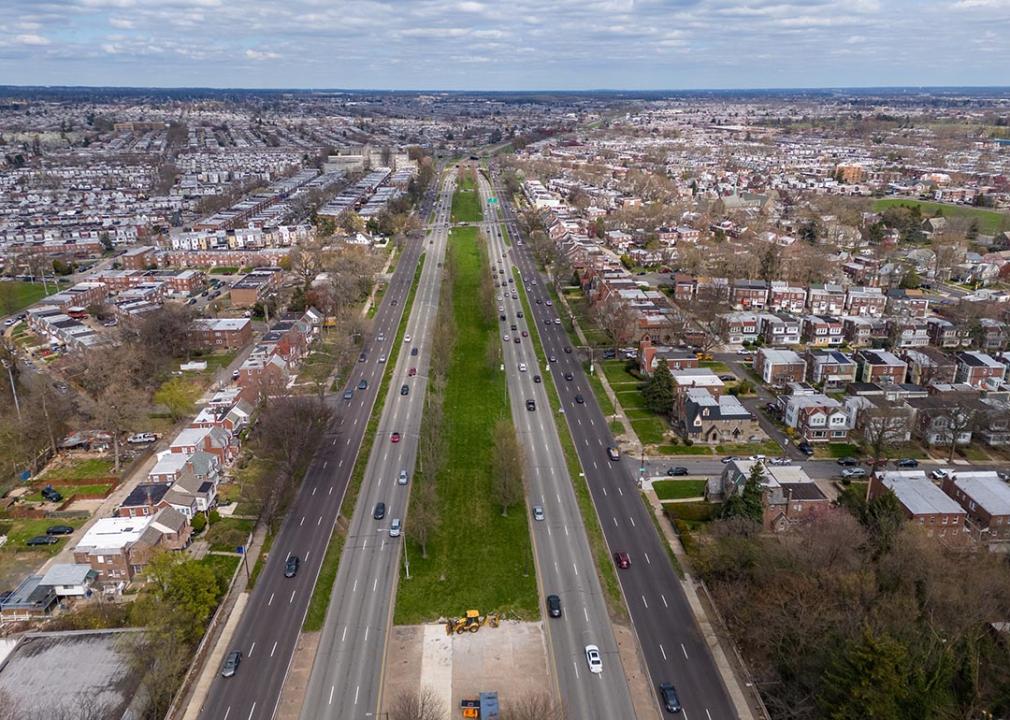What happened to crash rates when one state legalized speed cameras?
Next City unveils how after speed cameras were installed, a deadly boulevard in Philadelphia showed a drop in crashes.

The results are in: Speed cameras save lives, according to a study from the University of Pennsylvania. This is great news for cities and states seeking to reduce traffic fatalities and injuries as pedestrian deaths remain staggeringly high.
Next City reports that the success of the pilot is building momentum for more speed cameras in Philadelphia, as other cities across the U.S. are implementing their own programs. As evidence continues to mount that speed cameras work, will car-centric cities slow drivers to save lives?
A deadly road
Roosevelt Boulevard is a wide, fast 12-lane arterial that runs through multiple densely populated neighborhoods in northeast Philadelphia. "It's kind of like if you took a highway, but then just intersected it with the city," says Erick Guerra, associate professor at the University of Pennsylvania and an author of the study.
Roosevelt is so old that its origins as a deadly street can't even be traced to racism. Built in the early 20th century, it predates what we think of as "stroads," the term coined by urban planner Chuck Marohn to describe the combination of a street and road that sees a disproportionate amount of crashes.
"Maybe you could call it the original stroad, although I'm sure there's quite a few that are vying for that title," Guerra says.
In 2018, the Pennsylvania legislature approved a pilot program to place speed cameras along Roosevelt Boulevard — speed cameras were not legal before the legislation passed. Starting in June 2020, the city of Philadelphia placed cameras at eight locations and issued warnings to vehicles going 11 miles or more over the speed limit. After a 60-day grace period, speeding vehicles were fined. That year was a particularly deadly time for Philadelphia and other cities across the U.S. as reckless driving increased.
The study worked by studying crash rates on the boulevard before and after the speed cameras were installed, and comparing the numbers with other similar arterials during the same time period.
The results were clear, says Guerra. "Relative to other roads that are most similar to Roosevelt Boulevard in the city of Philadelphia, there was a substantial and statistically significant reduction in fatalities and crashes."
Ultimately, speed cameras work by changing driver behavior. A report from the Philadelphia Parking Authority found that speeding violations decreased by almost 90% along the sections of the Boulevard with cameras.
A simple solution
Speed cameras might seem like a simple solution to reduce traffic deaths, but some states in the U.S. are only recently starting to make them legal. Last year, California passed AB 645, allowing six cities to conduct their own speed camera pilots.
Unsurprisingly, not everyone is a fan. Critics say that they disproportionately punish Black, brown and low-income drivers and that changing street design would be a better solution.
But punishing drivers for dangerous behavior is the point. "All enforcement and all fines in the U.S. are regressive," notes Guerra. "You get a $100 fee whether you're a millionaire or barely scraping by. And I think that's problematic."
Advocates who support speed cameras are quick to point out that poor people and people of color are also more likely to be killed by traffic violence. They argue that using automated enforcement could replace the need for in-person traffic stops, which can be deadly for people of color.
Guerra supports sliding scale fines based on income — something that exists in Finland — but notes that this approach is a "political non-starter" in the U.S.
Critics often cast speed cameras as a "cash grab" for cities. According to traffic safety advocates, it's important for money to be reinvested directly into the community where the speed cameras are located. In the case of the pilot, the money is going to fund traffic safety projects, including $12 million to improve Roosevelt Boulevard by adding curb extensions and permeable pavement, among other upgrades.
Enforcement alone is not enough. Making Roosevelt safer will require more extensive intervention, says Guerra. The city could lower the speed limit or redesign it to remove a lane of traffic. Speed cameras are also not a perfect method of enforcement, with some evidence that drivers are obscuring their license plates to avoid fines.
"One of the sobering conclusions is that the boulevard still is the most dangerous roadway in Philadelphia. It still has really high traffic fatality rates and really high crash rates," he says.
Last December, the state legislature voted to make the Roosevelt speed camera program permanent and authorized speed cameras on five other corridors and five school zones. Speed cameras are not the only solution, but they are one part of the solution to reducing traffic violence.
"I do think redesigns are important [but] the built environment is not the only thing," says Guerra. "If it were, you wouldn't see Philadelphia's fatality rate double pre- and post-COVID — not quite double, but increase as dramatically as it did, because that was a shift in behavior."
This story was produced through Next City's Equitable Cities Fellowship for Social Impact Design, which is made possible with funding from the National Endowment for the Arts.
This story was produced by Next City, a nonprofit newsroom covering solutions for equitable cities, and reviewed and distributed by Stacker Media.
Comments





